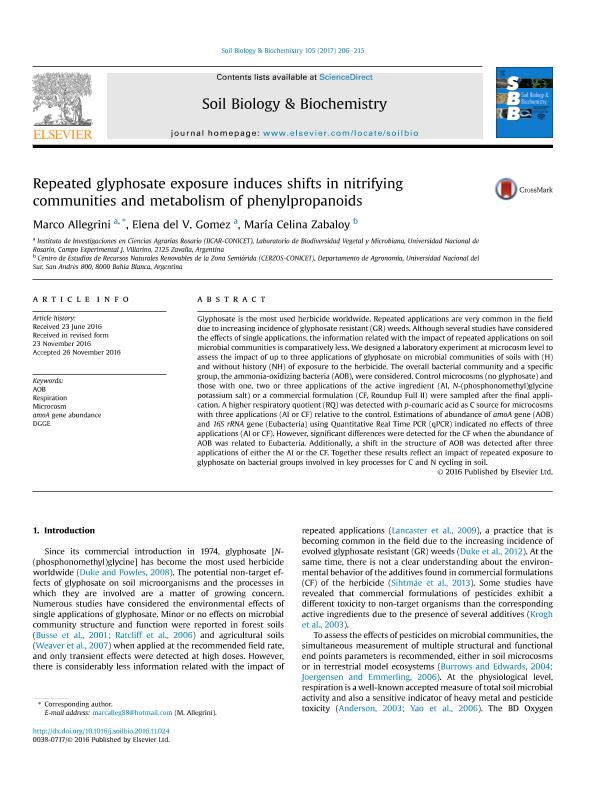Mostrar el registro sencillo del ítem
dc.contributor.author
Allegrini, Marco

dc.contributor.author
Gomez, Elena del Valle

dc.contributor.author
Zabaloy, Maria Celina

dc.date.available
2017-09-27T18:37:33Z
dc.date.issued
2017-02
dc.identifier.citation
Allegrini, Marco; Gomez, Elena del Valle; Zabaloy, Maria Celina; Repeated glyphosate exposure induces shifts in nitrifying communities and metabolism of phenylpropanoids; Elsevier; Soil Biology And Biochemistry; 105; 2-2017; 206-215
dc.identifier.issn
0038-0717
dc.identifier.uri
http://hdl.handle.net/11336/25241
dc.description.abstract
Glyphosate is the most used herbicide worldwide. Repeated applications are very common in the field due to increasing incidence of glyphosate resistant (GR) weeds. Although several studies have considered the effects of single applications, the information related with the impact of repeated applications on soil microbial communities is comparatively less. We designed a laboratory experiment at microcosm level to assess the impact of up to three applications of glyphosate on microbial communities of soils with (H) and without history (NH) of exposure to the herbicide. The overall bacterial community and a specific group, the ammonia-oxidizing bacteria (AOB), were considered. Control microcosms (no glyphosate) and those with one, two or three applications of the active ingredient (AI, N-(phosphonomethyl)glycine potassium salt) or a commercial formulation (CF, Roundup Full II) were sampled after the final application. A higher respiratory quotient (RQ) was detected with p-coumaric acid as C source for microcosms with three applications (AI or CF) relative to the control. Estimations of abundance of amoA gene (AOB) and 16S rRNA gene (Eubacteria) using Quantitative Real Time PCR (qPCR) indicated no effects of three applications (AI or CF). However, significant differences were detected for the CF when the abundance of AOB was related to Eubacteria. Additionally, a shift in the structure of AOB was detected after three applications of either the AI or the CF. Together these results reflect an impact of repeated exposure to glyphosate on bacterial groups involved in key processes for C and N cycling in soil.
dc.format
application/pdf
dc.language.iso
eng
dc.publisher
Elsevier

dc.rights
info:eu-repo/semantics/openAccess
dc.rights.uri
https://creativecommons.org/licenses/by-nc-sa/2.5/ar/
dc.subject
Amoa Gene Abundance
dc.subject
Aob
dc.subject
Dgge
dc.subject
Microcosm
dc.subject
Respiration
dc.subject.classification
Otras Agricultura, Silvicultura y Pesca

dc.subject.classification
Agricultura, Silvicultura y Pesca

dc.subject.classification
CIENCIAS AGRÍCOLAS

dc.title
Repeated glyphosate exposure induces shifts in nitrifying communities and metabolism of phenylpropanoids
dc.type
info:eu-repo/semantics/article
dc.type
info:ar-repo/semantics/artículo
dc.type
info:eu-repo/semantics/publishedVersion
dc.date.updated
2017-09-19T14:44:21Z
dc.journal.volume
105
dc.journal.pagination
206-215
dc.journal.pais
Países Bajos

dc.journal.ciudad
Amsterdam
dc.description.fil
Fil: Allegrini, Marco. Consejo Nacional de Investigaciones Científicas y Técnicas. Centro Científico Tecnológico Conicet - Rosario. Instituto de Investigaciones en Ciencias Agrarias de Rosario. Universidad Nacional de Rosario. Facultad de Ciencias Agrarias. Instituto de Investigaciones en Ciencias Agrarias de Rosario; Argentina
dc.description.fil
Fil: Gomez, Elena del Valle. Consejo Nacional de Investigaciones Científicas y Técnicas. Centro Científico Tecnológico Conicet - Rosario. Instituto de Investigaciones en Ciencias Agrarias de Rosario. Universidad Nacional de Rosario. Facultad de Ciencias Agrarias. Instituto de Investigaciones en Ciencias Agrarias de Rosario; Argentina
dc.description.fil
Fil: Zabaloy, Maria Celina. Consejo Nacional de Investigaciones Científicas y Técnicas. Centro Científico Tecnológico Conicet - Bahía Blanca. Centro de Recursos Naturales Renovables de la Zona Semiárida. Universidad Nacional del Sur. Centro de Recursos Naturales Renovables de la Zona Semiárida; Argentina
dc.journal.title
Soil Biology And Biochemistry

dc.relation.alternativeid
info:eu-repo/semantics/altIdentifier/url/http://www.sciencedirect.com/science/article/pii/S0038071716306411
dc.relation.alternativeid
info:eu-repo/semantics/altIdentifier/doi/http://dx.doi.org/10.1016/j.soilbio.2016.11.024
Archivos asociados
